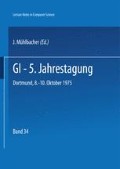Abstract
A measure of the complicacy of a program can be given considering the minimum number of exits of iterative blocks needed in order to write a program strongly equivalent to the given one.
On the basis of such intuitive notion we introduce in the paper a measure of the "structural complexity" of programs.
This complexity for arbitrary programs can be evaluated by constructing suitable well formed programs. The definition of well formedness is presented and it is shown to be a modification of the one given by Peterson, Kasami and Tokura. On the basis of the above definitions we present an algorithm to construct well formed programs and we prove that the notion of well formedness introduced is well founded.
This research has been sponsored by HISI under project AST and by C N R (Progetto speciale per l'Informatica)
Preview
Unable to display preview. Download preview PDF.
5) References
W.W. Peterson, T.Kasami and Tokura, "On the capabilities of while, repeat and exit statements", Comm. ACM (1973).
G. De Michelis and C. Simone, "Semantic characterization of Flow-diagrams and their decomposability", Proc. 2nd Colloquium on Automata, Languages and Programming, Springer (1974).
W.A. Wulf, D.B. Russel and N. Haberman, "BLISS: A language for system programming", Comm. ACM 14 (1971).
G. DeMichelis, G.A. Lanzarone and C. Simone "Control structures and control environments: a critical assesment"-GEC International report (1975).
C. Böhm and G. Jacopini, "Flow-diagrams, Turing machines and languages with only two formation rules", Comm. ACM 9 (May 1966).
S. Rao Kosaraju, "Analysis of structured programs", Proc. 5th Annual ACM Symposium Theory of Computing (1973).
N. Wirth, "On certain basic concepts of programming languages", STANCS-65 (1967).
D.E. Knuth, "Structured Programming with GOTO statements", Computing Surveys 6–4 (Dec. 1974).
A. Maggiolo Schettini and H.R. Strong, "A Graph-theoretic Algorithm for transforming Recursive Programs", Atti Congresso Informatica Teorica, Pisa (1973).
A.N. Gileadi and H.F. Ledgard: "On a proposed Measure of Program Structure" Sigplean Notices 9-5 (1974).
D.E. Knuth: "The art of Computer Programming: vol. 3" Addison Wesley (1973).
Author information
Authors and Affiliations
Editor information
Rights and permissions
Copyright information
© 1975 Springer-Verlag Berlin Heidelberg
About this paper
Cite this paper
De Michelis, G., Simone, C. (1975). Well formed programs optimal with respect to structural complexity. In: Mülbacher, J. (eds) GI — 5. Jahrestagung. GI 1975. Lecture Notes in Computer Science, vol 34. Springer, Berlin, Heidelberg. https://doi.org/10.1007/3-540-07410-4_629
Download citation
DOI: https://doi.org/10.1007/3-540-07410-4_629
Published:
Publisher Name: Springer, Berlin, Heidelberg
Print ISBN: 978-3-540-07410-6
Online ISBN: 978-3-540-37929-4
eBook Packages: Springer Book Archive

